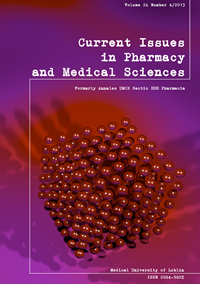Arginase/nitric oxide synthase regulatory mechanism of cells under the action of trigger factors that cause reactive arthritis
DOI:
https://doi.org/10.12923/j.2084-980X/26.4/a.06Słowa kluczowe:
arginase, L-arginine, NO-synthase, reactive arthritis, lymphocytesAbstrakt
On the basis of the research it can be argued that the determination of the enzymatic activity of arginase and NO-synthase of peripheral blood lymphocytes gives a qualitative informative assessment on the functioning of the immune cells, as changes in the activity of arginase reflect the NO metabolism. In the research, the optimal conditions of arginase reaction were determined and some of kinetic parameters of arginase were established. The significant growth of arginase activity (3.3 times) and iNO-synthase activity (3.8 times) in peripheral blood lymphocytes in patients with reactive arthritis compared with practically healthy donors was shown.
Bibliografia
1. Amour K.E. et al.: Evidence for a pathogenic role of nitric oxide in inflammation-induced osteoporosis. J. Bone Miner. Res., 14 (12), 2137, 1999.
2. 2. Bas S. et al.: Lower level of synovial fluid interferon-gamma in HLA-B27-positive than in HLA-B27-negative patients with Chlamidia trachomatis reactive arthritis. Rheumatology (Oxford), 42 ( 3), 461, 2003.
3. Boyum A. : Isolation of mononuclear cells and granulocytes from human blood. Scand. J. Clin. Lab. Invest., 21, (97), 77, 1968.
4. Cloke T.E. et al.: Increased level of arginase activity correlates with disease severity in HIV-seropositive patients. J. Infect Dis., 202 (3), 374, 2010.
5. Corraliza I. et al.: Increased expression of arginase II in patients with different forms of arthritis. Implications of the regulation of nitric oxide. J. Rheumatol., 29 (11), 2261, 2002.
6. Holan V. et al.: Production of nitric oxide during graft rejection is regulated by the Th1/Th2 balance, the arginase activity, and L-arginine metabolism. Transplantation, 81, 1708, 2006.
7. Huang L.W. et al.: Arginase levels are increased in patients with rheumatoid arthritis. Kaohsiung J. Med. Sci., 17 (7), 358, 2001.
8. Lowry O. H. et al.: Protein measurement with the Folin phenolreagent. J. Biol. Chem., 193, 265, 1951.
9. Morris S.M. Jr.: Enzymes of arginine metabolism . J. Nutr., 134 (10), 2743, 2004.
10. Ochoa J.B. et al.: Arginase I Expression and аctivity in human mononuclear cells after injury. Ann. Surg., 233 (3), 393, 2001.
11. Rivier C.: Role of nitric oxide and carbon monoxide in modulating the ACTH response to immune and nonimune signals. Neuroimmunomodulation, 5, 203, 1998.
12. Sarban S. et al.: Relationship between synovial fluid and plasma manganese, arginase, and nitric oxide in patients with rheumatoid arthritis. Biol. Trace Elem. Res., 115 (2), 97, 2007.
13. Verbuen A. et al.: Influence of blood and synovia fluid immune complexes of patients with rheumatoid arthritis on production of nitric oxide and rowth and viability of chondrocytes. J. Rheumatol., 27 (1), 35, 2000.
14. Virgili F. et al.: Procyanidins extracted from Pinus maritime: scavengers of free radical species and modulators of nitrogen monoxide metabolism inactivated murine RAW 264/7 macrophages. Free Radical Biol. Med., 24 (7-8), 1120, 1998.
15. Wanchu A. et al.: Elevated nitric oxide production in patients with primary Sjogren’s syndrome. Clin. Rheumatol., 19 (5), 360, 2000.
Pobrania
Opublikowane
Numer
Dział
Licencja
Prawa autorskie (c) 2013 Autorzy

Praca jest udostępniana na licencji Creative Commons Attribution-NonCommercial-NoDerivatives 3.0 Unported License.


